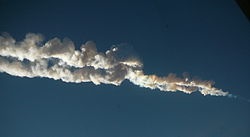The meteor that crashed in Chelyabinsk, Russia on Thursday, February 15th was the largest object to hit the Earth in more than a century. It stretched 55 feet in diameter and weighed around 10,000 pounds; a size that allowed the projectile to unleash 500 kilitons of energy as it collided with our surface – a force more than 30 times the energy of the Hiroshima atomic bomb. With the bomb-like explosion came war-like results, as the industrial city experienced broad property damage and more than 1,200 people were injured. Imagine if that hit New York.
Well, chances are that it probably won’t in our lifetimes. Paul Chodas of NASA’s Near-Earth Object Program Office demonstrated the rarity of the event by stating, “We would expect an event of this magnitude to occur once every 100 years.” But what makes these meteor attacks so rare? Something called “the atmospheric entry process,” which is the specific movement of human-made or natural objects as they penetrate the atmosphere from a celestial body from outer space.
These objects must enter at specific speeds and specific angles, otherwise they would deteriorate from heat and friction or simply be bounced back into space. For example, space shuttles reentering Earth must penetrate the atmosphere at a 40-degree angle. Talk about using math in a real-life situation. So, we are actually being bombarded by objects from space everyday. In order to enter Earth, however, these objects need to make the perfect entrance, making entry a rare occurrence.
The Russian meteor blast should open our eyes about the possible threat of future meteors. They are no longer science fiction, or just that thing that killed the dinosaurs. Meteors present an eminent and unstoppable threat, and although they are beautifully powerful to watch, meteors are the most dangerous weapon.
http://en.wikipedia.org/wiki/Atmospheric_entry
